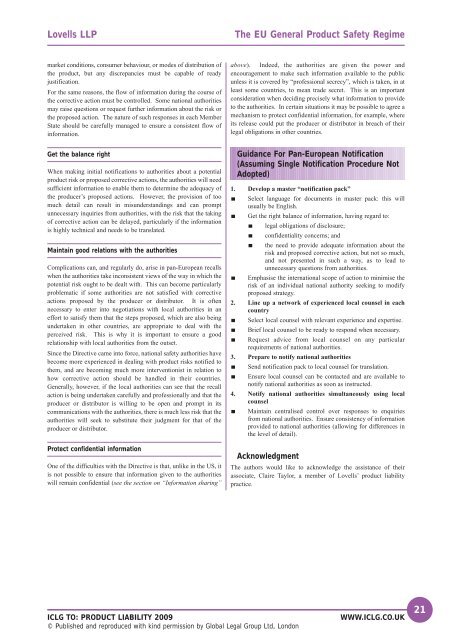Product Liability 2009 - Arnold & Porter LLP
Product Liability 2009 - Arnold & Porter LLP
Product Liability 2009 - Arnold & Porter LLP
Create successful ePaper yourself
Turn your PDF publications into a flip-book with our unique Google optimized e-Paper software.
Lovells <strong>LLP</strong> The EU General <strong>Product</strong> Safety Regime<br />
market conditions, consumer behaviour, or modes of distribution of<br />
the product, but any discrepancies must be capable of ready<br />
justification.<br />
For the same reasons, the flow of information during the course of<br />
the corrective action must be controlled. Some national authorities<br />
may raise questions or request further information about the risk or<br />
the proposed action. The nature of such responses in each Member<br />
State should be carefully managed to ensure a consistent flow of<br />
information.<br />
Get the balance right<br />
When making initial notifications to authorities about a potential<br />
product risk or proposed corrective actions, the authorities will need<br />
sufficient information to enable them to determine the adequacy of<br />
the producer’s proposed actions. However, the provision of too<br />
much detail can result in misunderstandings and can prompt<br />
unnecessary inquiries from authorities, with the risk that the taking<br />
of corrective action can be delayed, particularly if the information<br />
is highly technical and needs to be translated.<br />
Maintain good relations with the authorities<br />
Complications can, and regularly do, arise in pan-European recalls<br />
when the authorities take inconsistent views of the way in which the<br />
potential risk ought to be dealt with. This can become particularly<br />
problematic if some authorities are not satisfied with corrective<br />
actions proposed by the producer or distributor. It is often<br />
necessary to enter into negotiations with local authorities in an<br />
effort to satisfy them that the steps proposed, which are also being<br />
undertaken in other countries, are appropriate to deal with the<br />
perceived risk. This is why it is important to ensure a good<br />
relationship with local authorities from the outset.<br />
Since the Directive came into force, national safety authorities have<br />
become more experienced in dealing with product risks notified to<br />
them, and are becoming much more interventionist in relation to<br />
how corrective action should be handled in their countries.<br />
Generally, however, if the local authorities can see that the recall<br />
action is being undertaken carefully and professionally and that the<br />
producer or distributor is willing to be open and prompt in its<br />
communications with the authorities, there is much less risk that the<br />
authorities will seek to substitute their judgment for that of the<br />
producer or distributor.<br />
Protect confidential information<br />
One of the difficulties with the Directive is that, unlike in the US, it<br />
is not possible to ensure that information given to the authorities<br />
will remain confidential (see the section on “Information sharing”<br />
ICLG TO: PRODUCT LIABILITY <strong>2009</strong><br />
© Published and reproduced with kind permission by Global Legal Group Ltd, London<br />
above). Indeed, the authorities are given the power and<br />
encouragement to make such information available to the public<br />
unless it is covered by “professional secrecy”, which is taken, in at<br />
least some countries, to mean trade secret. This is an important<br />
consideration when deciding precisely what information to provide<br />
to the authorities. In certain situations it may be possible to agree a<br />
mechanism to protect confidential information, for example, where<br />
its release could put the producer or distributor in breach of their<br />
legal obligations in other countries.<br />
Guidance For Pan-European Notification<br />
(Assuming Single Notification Procedure Not<br />
Adopted)<br />
1. Develop a master “notification pack”<br />
Select language for documents in master pack: this will<br />
usually be English.<br />
Get the right balance of information, having regard to:<br />
legal obligations of disclosure;<br />
confidentiality concerns; and<br />
the need to provide adequate information about the<br />
risk and proposed corrective action, but not so much,<br />
and not presented in such a way, as to lead to<br />
unnecessary questions from authorities.<br />
Emphasise the international scope of action to minimise the<br />
risk of an individual national authority seeking to modify<br />
proposed strategy.<br />
2. Line up a network of experienced local counsel in each<br />
country<br />
Select local counsel with relevant experience and expertise.<br />
Brief local counsel to be ready to respond when necessary.<br />
Request advice from local counsel on any particular<br />
requirements of national authorities.<br />
3. Prepare to notify national authorities<br />
Send notification pack to local counsel for translation.<br />
Ensure local counsel can be contacted and are available to<br />
notify national authorities as soon as instructed.<br />
4. Notify national authorities simultaneously using local<br />
counsel<br />
Maintain centralised control over responses to enquiries<br />
from national authorities. Ensure consistency of information<br />
provided to national authorities (allowing for differences in<br />
the level of detail).<br />
Acknowledgment<br />
The authors would like to acknowledge the assistance of their<br />
associate, Claire Taylor, a member of Lovells’ product liability<br />
practice.<br />
WWW.ICLG.CO.UK 21





